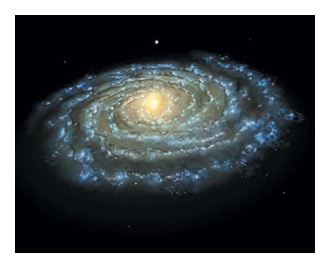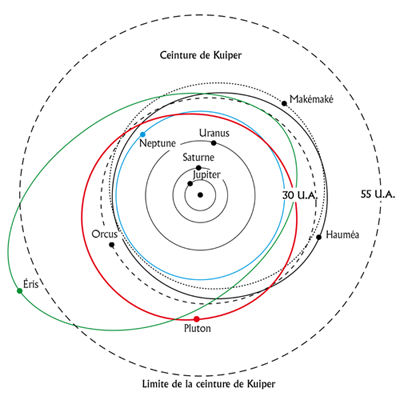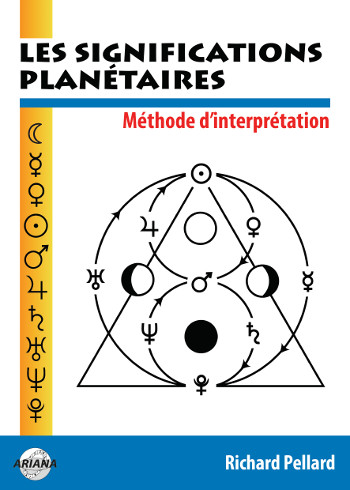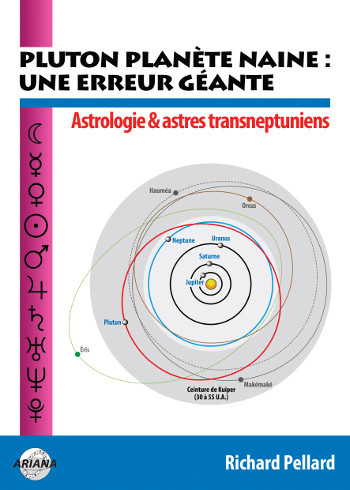Your Planets
Portraits of the Planets
Aspects between Planets
The planetary ages
The planetary families
Planets in Signs
The Planets in comics


The object of study of astrology is the relationship between human behavior and the stars that make up the solar system. Before looking at the influences and “meanings” given to these celestial bodies, it is therefore essential to have an elementary knowledge of their astronomical characteristics.
 To begin, let’s locate the solar system within the cosmos. The cosmos is made up of billions of billions of stars, that is to say bodies that shine with their own light. Due to the laws of universal gravitation, every celestial body revolves around another. These stars thus group together in galaxies, and revolve around the center of these galaxies. The most common form of galaxy is the spiral galaxy. A spiral galaxy consists of a central core surrounded by spiral arms wrapped around this core. It is in these spiral arms that gases and stars are concentrated.
To begin, let’s locate the solar system within the cosmos. The cosmos is made up of billions of billions of stars, that is to say bodies that shine with their own light. Due to the laws of universal gravitation, every celestial body revolves around another. These stars thus group together in galaxies, and revolve around the center of these galaxies. The most common form of galaxy is the spiral galaxy. A spiral galaxy consists of a central core surrounded by spiral arms wrapped around this core. It is in these spiral arms that gases and stars are concentrated.
The galaxy to which the solar system belongs is precisely a spiral galaxy: the Milky Way, that whitish streak that, from Earth, we can observe in the night sky. The Milky Way, which is made up of over one hundred billion stars, is about 100,000 light years in diameter (to give you an idea of what this means, multiply 10,000 billion kilometers by 100,000). The solar system is located just a little outside of one of the four spiral arms, that is to say in the “outskirts” of the Milky Way. Its diameter is 12 billion kilometers: compared to the size of the galaxy to which it belongs, it is therefore tiny. The solar system revolves around the center of the Milky Way at the speed of 220 kilometers per second, and it takes about 220 million years to complete one revolution.
 The solar system is the set of stars that revolve around the Sun. The Sun is an ordinary medium-sized star, around which revolve planets (celestial bodies without their own light and of fairly large volume), asteroids (small planets) and comets (tiny asteroids caught up in the Sun’s gravitational field). The outer shell of the solar system, beyond the orbit of Pluto, is called the Oort cloud. It is mainly made up of comets.
The solar system is the set of stars that revolve around the Sun. The Sun is an ordinary medium-sized star, around which revolve planets (celestial bodies without their own light and of fairly large volume), asteroids (small planets) and comets (tiny asteroids caught up in the Sun’s gravitational field). The outer shell of the solar system, beyond the orbit of Pluto, is called the Oort cloud. It is mainly made up of comets.
What interests astrology above all are the Sun, the planets and the Moon, satellite (star in orbit around a planet) of the Earth. For convenience, astrologers call “planets” all major celestial bodies. So remember that, from an astronomical point of view, the Sun and the Moon are not planets, but respectively a star and a satellite. The Planets (the capital letter makes it possible not to confuse the astronomical and astrological concepts) taken into account by astrology are 10 in number: Sun, Moon, Mercury, Venus, Mars, Jupiter, Saturn, Uranus, Neptune and Pluto.
This brief presentation of the solar system is over. You now know that astrology is not about the influence of distant stars on human behavior, and that the solar system is a tiny whole within the vastness of the cosmos. On the scale of the Earth, it becomes capital. Inhabitants of the Earth, we are intimately part of it. He is like our close cosmic family. We are born within it, and it exerts a powerful, subtle, and invisible influence upon us through the solo-planetary cycles and rhythms.
It now remains to present the 10 Planets, which can be classified into two groups: the fast ones (Sun, Moon, Mercury, Venus, Mars) and the slow ones (Jupiter, Saturn, Uranus, Neptune, Pluto).
Name: the Mesopotamians, discoverers of astrology and astronomy, called it Shamash. Its current name, Sun, comes from the Latin solis, which means “alone, single”, which designates the fact that it is the one and only star at the center of the solar system.
Features: the Sun is a large ball 1.4 million kilometers in diameter, composed mainly of hydrogen and a little helium. Its center is a nuclear furnace (15 million degrees) which produces the solar energy without which all life on Earth would be impossible. Its diameter is about 109 times that of the Earth. It rotates around its axis from west to east, like the Earth. It moves, relative to the neighboring stars, towards the constellation of Hercules at the speed of 19.4 kilometers per second. The Sun is surrounded by the heliosphere (part of the cosmos including the solar system, under the influence of the multiple energies produced by the Sun).
Name: the Mesopotamians called it Shin. Its current name comes from the Latin luna.
Features: the Moon is the only satellite of planet Earth. It is made up of rocks covered with dust and it has no atmosphere. Its diameter is 27% that of the Earth, which is enormous and extremely rare for a satellite (the only other known case: Chiron, the satellite of Pluto, has a diameter which represents 40% of that of Pluto) certain astronomers that the Earth-Moon couple would constitute more of a “dual planet” than a planet-satellite duo. Its sidereal revolution is 27 1/3 days and it turns on itself for the same time, which means that it always presents the same face to us. We know that solar heat and light are essential to our survival… we know less that the Moon is too. Indeed, for the past ten years, we have learned that the axes of rotation of many planets in the solar system have been or are chaotic. Over very long astronomical periods, the inclination of Mars, for example, oscillates between 0° and 60°. The Earth benefited from the presence of its very large satellite: the Moon. The gravitational force exerted by the Moon has stabilized the chaotic movements of the Earth’s axis of rotation: it is estimated that if the Moon did not exist, the axis of our globe would oscillate chaotically by about 50° in a few million years. However, we know that a variation of only 1.3° around the average inclination of the Earth (23.5°) with respect to the plane of its orbit plays a crucial role in the appearance of ice ages. Conclusion of astronomer Jacques Laskar: “We can estimate (in the absence of the Moon) that the disturbances would have been such that the appearance of life would have been strongly thwarted if not made impossible… Without the Moon we would probably not be here.”
Name: the Mesopotamians called it Nabu or Goud Oud. Its current name comes from the name of the god of the Roman pantheon Mercury, himself assimilated to Hermes of the Greek pantheon.
Features: Mercury is the fastest and closest planet to the Sun. Its extreme distance from Earth ranges from 79 to 218 million km. It is a little bigger than the Moon and a little smaller than Mars: with Pluto, it is one of the two smallest planets in the solar system. It’s a planet “telluric”, that is to say essentially composed of solid materials. Its bark resembles that of the moon. It has no atmosphere and has had no geological activity for billions of years. The high eccentricity of its orbit causes its distance from the Sun to vary greatly. It turns on its axis in about 60 days. Its duration of sidereal revolution (time taken to make a complete revolution in its orbit) is 87 days, 23 hours and 16 minutes. Seen from Earth, Mercury never moves more than 28° from the Sun: it can therefore only be observed at dawn or dusk; outside of these periods, the brilliance of sunlight hides it from our eyes. At its peak, when the sky is dark enough and it is closest to Earth, it shines like a star.
Name: the Mesopotamians called it Ishtar or Delephot. Its current name comes from the name of the goddess of the Roman pantheon Venus, herself assimilated to the Aphrodite of the Greek pantheon.
Features: Venus (also incorrectly called “Evening Star”) orbits in the second orbit of the solar system. Its extreme distance from Earth ranges from 39 to 258 million km. Terrestrial planet like Mercury, Earth and Mars, planet “interior” (because it is inside the orbit of the Earth) like Mercury, it has an atmosphere composed of 97% carbon dioxide in which evolve clouds of sulfuric acid. Its sidereal revolution is 225 days and its diameter is almost identical to that of the Earth. It is the planet with the most circular orbit; therefore, its distance from the Sun is almost constant. It rotates on its axis in about 23 hours in a retrograde direction (from east to west), which is a unique case in the solar system. Seen from the Earth, it never strays far from the Sun (46° maximum). Like Mercury, it is therefore only visible at dawn and dusk. After the Sun and the Moon, Venus is the brightest star in the sky when it comes closest to the Earth: at these times, its brightness reaches 12 times that of Sirius, the brightest star, and its apparent diameter is only 25 times smaller than that of the Moon.
Name: the Mesopotamians called it Nergal. Its current name comes from the name of the god of the Roman pantheon Mars, himself assimilated to Ares of the Greek pantheon.
Features: Mars, succeeding the Earth in the order of the distances to the Sun, gravitates on the fourth orbit of the solar system and signals itself to our eyes by its reddish color. Its extreme distance from Earth ranges from 55 to 400 million km. He is about half the size of her and two satellites revolve around him. First and first telluric planet “exterior” (because it is located outside the orbit of the Earth), its soil is very rich in iron and its atmosphere is 95% composed of carbon dioxide. Its sidereal revolution is 1 year 322 days and it rotates in 24 h 37. Mars’ orbit is very elliptical (it looks more like an oval than a circle). As a result, seen from the Earth, its apparent diameter is multiplied by five depending on whether it is closest or furthest from our home planet. This phenomenon created panic in all the theories of astronomers until one of them, Johannes Kepler, discovered by reflecting on the irregularity of the movements and apparent diameters of Mars, that the orbits of the planets are not circular.
Name: the Mesopotamians called it Marduk. Its current name comes from the name of the god of the Roman pantheon Jupiter, himself assimilated to Zeus of the Greek pantheon.
Features: Jupiter is the first and largest of the giant planets in the solar system. Its extreme distance from Earth ranges from 586 to 964 million km. Its diameter is about eleven times that of the Earth and it is 1000 times larger than it. Its mass alone is one and a half times that of all the other planets combined. Around a small core, probably rocky, it is mainly made of metallic, molecular and gaseous hydrogen, and its atmosphere is swept by clouds of methane and ammonia. The duration of its sidereal revolution is 11 years 314 days and it turns on itself in 9 h 50. It has twelve known satellites, one of which, Ganymede, is larger in diameter than Mercury. Some astronomers believe that Jupiter would be a “failed star”, an aborted Sun which could not have ignited due to insufficient mass. It is not impossible, given that with its cortege of satellites it looks like a solar system in miniature, and that there are in the cosmos a majority of double stars.
Name: the Mesopotamians called him Ninib. Its current name comes from the name of the god of the Roman pantheon Saturn, himself assimilated to Chronos of the Greek pantheon.
Features: Its diameter is about 9 times that of the Earth and it is 750 times larger than it. Its extreme distance from Earth ranges from 1290 to 1650 million km. Saturn is the second giant of the solar system, but it is half as dense as Jupiter: if we placed it on an ocean of its size, it would float! According to our current knowledge, it is made of the same physical materials as Jupiter, with the exception of metallic hydrogen, which is much less present. The duration of its sidereal revolution is 29 years 167 days and it turns on itself in 10 h 14. Ten satellites are known to him. For a long time, it was believed that it was the only one surrounded by rings made up of rock fragments and icicles. We now know that this is also the case for Uranus, and perhaps also for Neptune. For millennia, Saturn was thought to be the last planet in the solar system.
Name: the Mesopotamians did not call it, since, like Neptune and Pluto, Uranus is invisible to the naked eye and requires, in order to be observed, very powerful telescopes which did not exist at the time. Its name comes from the name of god of the Roman pantheon Uranus.
Features: discovered in 1781, Uranus has a diameter about 4 times that of Earth. Its distance from Earth is 2583 million km. It is made up, like Neptune, of an atmosphere of methane clouds (which give these two planets a greenish-bluish color) enveloping molecular hydrogen which itself surrounds ice, which encloses a rocky core of weak overall dimensions. Unique case in the solar system, the axis of rotation of Uranus is literally “layer” in its orbit: it is a bit as if the axis of the North and South poles of the Earth were no longer “horizontal”, but “vertical”! It is very cold on its surface: −180°. Normal, it is very, very far from the Sun (3 million kilometers, while Saturn is “only” 1.5 million away…). Its duration of sidereal revolution is 84 years 7 days and it turns on itself in 10 h 42. It is currently assigned five satellites.
Name: its name comes from the name of the god of neptune roman pantheon (Poseidon in Greek).
Features: discovered in 1846, Neptune has a distance from the Earth of 4304 million km. In all respects, it looks a lot like Uranus, except that its axis of rotation is not perpendicular to its orbit. Its diameter is, like that of Uranus, almost 4 times greater than that of the Earth. Its duration of sidereal revolution is 164 years 280 days and it turns on itself in 15 h 48. It is currently assigned two satellites.
Name: its name comes from the name of the god of Roman pantheon Pluto (Hades in Greek).
Features: Discovered in 1930, Pluto has an average distance from the Sun of about 6 billion kilometers. But given the very high eccentricity of its orbit, this distance varies between 4.4 (it is then closer to the Sun than Neptune, whose orbit it crosses!) and 7.4 billion kilometres. A unique phenomenon in the solar system, its orbit is also very strongly inclined (17°) with respect to the ecliptic (apparent plane of the course of the Sun around the Earth). Its estimated diameter is 2400 km (that of the Moon is 3476 km, and that of Mercury 4878 km). We do not know exactly what it is made of, except that it is not a gaseous planet like the “giantess” Jupiter, Saturn, Uranus and Neptune, and that it would be covered in a shell of frozen methane. Its duration of sidereal revolution is 247 years 249 days and it turns on itself, it is estimated, in 6 days and 9 hours. Pluto has only one known satellite, Charon (not to be confused with Chiron, an asteroid that orbits between Saturn and Uranus).
The General Assembly of the International Astronomical Union (IAU) met in Prague from 14th to 24th August 2006 to agree on the definition of the word “planet”. During this surreal session, she decided that Pluto was no longer just a planet, but a “dwarf planet”, which has changed absolutely nothing to its astronomical and astrological characteristics.
Between the orbit of Mars and that of Jupiter, there is a asteroid belt which is between 310 and 520 million km from the Sun. The first of them was discovered in 1801 and called Ceres, from the name of the Roman goddess (Demeter among the Greeks). A year later a second was discovered, Pallas. Since then, we keep discovering new ones. It is currently estimated that there would be around 50,000. Their diameter ranges from 1000 km for Ceres, which is the largest, to a few hundred meters for the smallest. Their sidereal revolution times range from 3.63 years (Vesta) to 6.33 (Cybele). That of Ceres is intermediate: 4.60 years. Astronomers think either that it is the debris of a planet which would have exploded (this hypothetical star is called Phaeton), or the residue of a proto-solar nebula which would not have succeeded in aggregating to form a single star, or that these asteroids are on the contrary in the process of agglomeration, and that they will give birth to a new planet in billions of years.
Some symbolist astrologers believe that it is necessary to position “The biggest” of these asteroids in the natal horoscope and interpret the effects. But according to what criteria, what objective measures do they determine the “bigger” and the “smaller”? They don’t say anything about it… and for good reason: they don’t know anything about it.
This asteroid was discovered in 1977. Its orbit, which lies between those of Saturn and Uranus, is so eccentric that its distance from the Sun ranges from 1300 to 2800 million kilometers from the Sun, which makes it cross the orbit of Saturn. Its diameter is estimated at about 400 km. Its sidereal revolution time is 50 years. Astronomers believe that it would be an ancient satellite of a giant planet which would have “released” following a collision, either of a comet foreign to the solar system would have been “snapped up” by passing through the gravitational field of the Sun. Again, some astrologers believe that Chiron should be positioned in the birth chart and interpreted.
Like Chiron, this asteroid is probably a comet caught in the solar system. Its very eccentric orbit makes it successively pass through the asteroid belt and the orbit of Jupiter until it reaches its extreme distance from the Sun of 900 million km and thus approaches the orbit of Saturn. No astrologer has ever thought of integrating and interpreting it. It’s not fair to poor Hidalgo.
▶ Astronomy of planets
▶ La ceinture d’astéroïdes entre Mars et Jupiter
▶ The deplanetization of Pluto, a hysterical decision
▶ Les astres transplutoniens
▶ Varuna et la bêtise astrologique

Les significations planétaires
par
620 pages. Illustrations en couleur.
La décision de ne traiter dans ce livre que des significations planétaires ne repose pas sur une sous-estimation du rôle des Signes du zodiaque et des Maisons. Le traditionnel trio Planètes-Zodiaque-Maisons est en effet l’expression d’une structure qui classe ces trois plans selon leur ordre de préséance et dans ce triptyque hiérarchisé, les Planètes occupent le premier rang.
La première partie de ce livre rassemble donc, sous une forme abondamment illustrée de schémas pédagogiques et tableaux explicatifs, une édition originale revue, augmentée et actualisée des textes consacrés aux significations planétaires telles qu’elles ont été définies par l’astrologie conditionaliste et une présentation détaillée des méthodes de hiérarchisation planétaire et d’interprétation accompagnées de nombreux exemples concrets illustrés par des Thèmes de célébrités.
La deuxième partie est consacrée, d’une part à une présentation critique des fondements traditionnels des significations planétaires, d’autre part à une présentation des rapports entre signaux et symboles, astrologie et psychologie. Enfin, la troisième partie présente brièvement les racines astrométriques des significations planétaires… et propose une voie de sortie de l’astrologie pour accéder à une plus vaste dimension noologique et spirituelle qui la prolonge et la contient.
Téléchargez-le dès maintenant dans notre boutique

Pluton planète naine : une erreur géante
par
117 pages. Illustrations en couleur.
Pluton ne fait plus partie des planètes majeures de notre système solaire : telle est la décision prise par une infime minorité d’astronomes lors de l’Assemblée Générale de l’Union Astronomique Internationale qui s’est tenue à Prague en août 2006. Elle est reléguée au rang de “planète naine”, au même titre que les nombreux astres découverts au-delà de son orbite.
Ce livre récapitule et analyse en détail le pourquoi et le comment de cette incroyable et irrationnelle décision contestée par de très nombreux astronomes de premier plan. Quelles sont les effets de cette “nanification” de Pluton sur son statut astrologique ? Faut-il remettre en question son influence et ses significations astro-psychologiques qui semblaient avérées depuis sa découverte en 1930 ? Les “plutoniens” ont-ils cessé d’exister depuis cette décision charlatanesque ? Ce livre pose également le problème des astres transplutoniens nouvellement découverts. Quel statut astrologique et quelles influences et significations précises leur accorder ?
Enfin, cet ouvrage propose une vision unitaire du système solaire qui démontre, chiffes et arguments rationnels à l’appui, que Pluton en est toujours un élément essentiel, ce qui est loin d’être le cas pour les autres astres au-delà de son orbite. Après avoir lu ce livre, vous saurez quoi répondre à ceux qui pensent avoir trouvé, avec l’exclusion de Pluton du cortège planétaire traditionnel, un nouvel argument contre l’astrologie !
Téléchargez-le dès maintenant dans notre boutique